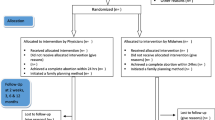Abstract
Background
Medical method of abortion (MMA) is a safe, efficient, and affordable method of abortion. However, incomplete abortion is a known side effect.
Objective
To study incomplete abortion due to medication abortion and compare to spontaneous incomplete abortion and to study referral practices and prescriptions in cases of incomplete abortion following MMA.
Method
Prospective observational study of 100 women with first trimester incomplete abortion, divided into two groups (spontaneous or following MMA), was administered a questionnaire which included information regarding onset of bleeding, treatment received, use of medications for abortion, its prescription, and administration. Comparison of two groups was done using Fisher exact test (SPSS 21.0 software).
Results
Thirty percent of incomplete abortions were seen following MMA; possible reasons being self-administration or prescription by unregistered practitioners, lack of examination, incorrect dosage and drugs, and lack of follow-up. Complications such as collapse, blood requirement, and fever were significantly higher in these patients compared to spontaneous abortion group.
Conclusion
The side effects of incomplete abortions following MMA can be avoided by the following standard guidelines. Self medication, over- the-counter use, and prescription by unregistered doctors should be discouraged and reported, and need of follow-up should be emphasized.

Similar content being viewed by others
References
The medical termination of pregnancy amendment act, 2002. No. 62 of 2002, 18th December 2002.
World Health Organization. Unsafe abortion: global and regional estimates of the incidence of unsafe abortion and associated mortality in 2003. 5th ed. Geneva: World Health Organization; 2007.
Thoai DN, Park MH, Shakur H, et al. Home-based versus clinic-based medical abortion: systematic review. Bull World Health Organ. 2011;89:360–70.
Comprehensive abortion care training and service delivery guideline. Ministry of Health and Family Welfare Government of India 2010.
Mundle S, Elul B, Anand A, et al. Increasing access to safe abortion services in rural India: experiences with medical abortion in a primary health centre. Contraception. 2007;6:66–70.
Coyaji K, Elul B, Krishna U, et al. Mifepristone-misoprostol abortion: a trial in rural and urban Maharashtra. India. Contraception. 2002;66:33–40.
Kopp Kallner H, Fiala C, Stephansson O, et al. Home self-administration of vaginal misoprostol for medical abortion at 50–63 days compared with gestation of below 50 days. Hum Reprod. 2010;25:1153–7.
Kahn JG, Becker BJ, MacIssac L, et al. The efficacy of medical abortion: a meta-analysis statistics. standford.edu/ckirby/techrepots/GEN/1999/1999-29.
Winikoff B, Sivin I, Coyaji KJ, et al. Safety, efficacy, and acceptability of medical abortion in China, Cuba, and India: a comparative trial of mifepristone-misoprostol versus surgical abortion. Am J Obstet Gynecol. 1997;176:431–7.
Duggal R, Barge S.: Abortion services in India: report of a multi-centric inquiry. http://www.Cehat.org/aap.html (2002). Accessed 21 Feb 2012.
Henderson JT, Hawng AC, Harper CC, et al. Safety of mifepristone abortion in clinical use. Contraception. 2005;72:175–8.
Shenon C, Perry Brothers L, Philip NM, et al. Infection after medical abortion: a review of literature. Contraception. 2004;70:183–90.
Bhutta SZ, Aziz S, Korejo R. Surgical complications following unsafe abortion. JPMA. 2003;53:286–90.
Compliance with ethical requirements and Conflict of interest
Anuya A Pawde, Arun Ambadkar, and Anahita R Chauhan declare that they have no conflict of interest. All procedures followed were in accordance with the ethical standards of the institutional Ethics Committee (Committee for Academic Research Ethics 2011) and with the Helsinki Declaration of 1975, as revised in 2008 (5). Informed consent was obtained from all patients before being included in the study.
Author information
Authors and Affiliations
Corresponding author
Rights and permissions
About this article
Cite this article
Pawde, A.A., Ambadkar, A. & Chauhan, A.R. A Study of Incomplete Abortion Following Medical Method of Abortion (MMA). J Obstet Gynecol India 66, 239–243 (2016). https://doi.org/10.1007/s13224-015-0673-1
Received:
Accepted:
Published:
Issue Date:
DOI: https://doi.org/10.1007/s13224-015-0673-1



